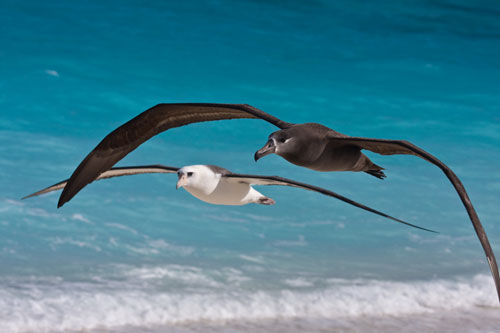Michelle Kappes and her co-authors used satellite trackers on Hawaiian Laysan and Black-footed Albatrosses over four breeding seasons to search for changes in foraging behaviour in relation to climatic and oceanographic variability. Their findings have recently appeared in a paper published on line in the journal Progress in Oceanography.
The paper's abstract follows:
"We studied the foraging behavior and marine habitats used by Laysan (Phoebastria immutabilis) and Black-footed (Phoebastria nigripes) Albatrosses, during four consecutive breeding seasons to investigate whether these marine predators changed habitat preferences, foraging distributions, or both, in accordance with natural interannual variability in the marine environment. We used satellite telemetry to track a total of 37 Laysan and 36 Black-footed Albatrosses during the incubation periods of 2002-2006 at Tern Island, Northwest Hawaiian Islands. First passage time analysis was used to determine search effort of individual albatrosses along their respective tracks, and this metric was then related to oceanographic habitat variables using linear mixed-effects regression. The majority of individuals traveled to pelagic waters of the North Pacific, with Laysan Albatrosses demonstrating a more northwesterly distribution from the breeding colony. Laysan Albatrosses traveled farther, for longer periods, and demonstrated greater interannual variability in trip characteristics than Black-footed Albatrosses. For Laysan Albatrosses, maximum trip distance was negatively correlated with body mass change during foraging and overall breeding success. There was considerable interspecific segregation of foraging habitats, and low overlap of foraging distributions between years. For all years, and both species, sea surface temperature was consistently the most important environmental variable predicting search effort of albatrosses, suggesting that both species use similar environmental cues when searching for prey. In the context of climate variability, our results suggest that Hawaiian albatrosses demonstrate flexibility in foraging strategies and track preferred marine habitats. However, adjusting foraging behavior to climatic variability may have energetic and subsequent reproductive consequences."
Reference:
Michelle A. Kappes, Scott A. Shaffer, Yann Tremblay, David G. Foley, Daniel M. Palacios, Patrick W. Robinson, Steven J. Bograd & Daniel P. Costa 2010. Hawaiian albatrosses track interannual variability of marine habitats in the North Pacific. Progress in Oceanography (click here).

Thanks to Lindsay Young, ACAP North Pacific News Correspondent for the alert.
John Cooper, ACAP Information Officer, 5 June 2010

 English
English  Français
Français  Español
Español